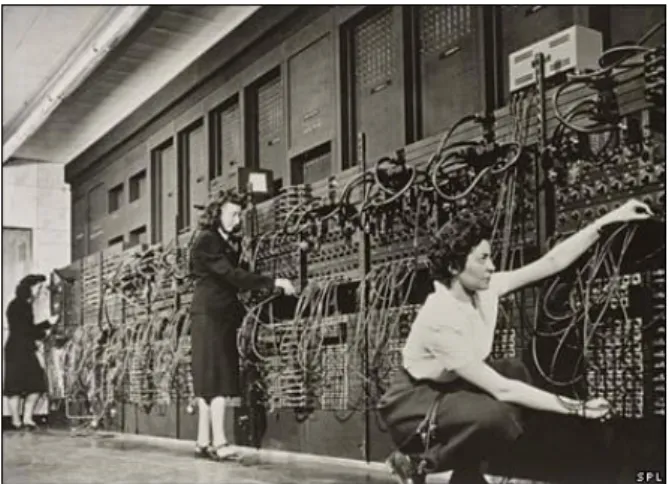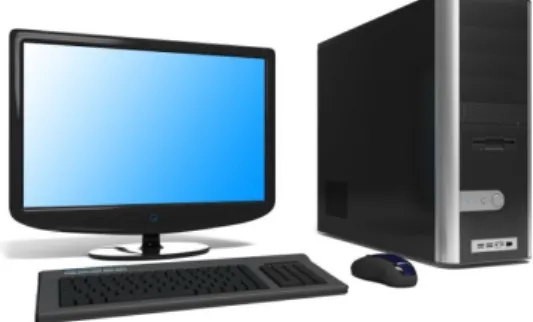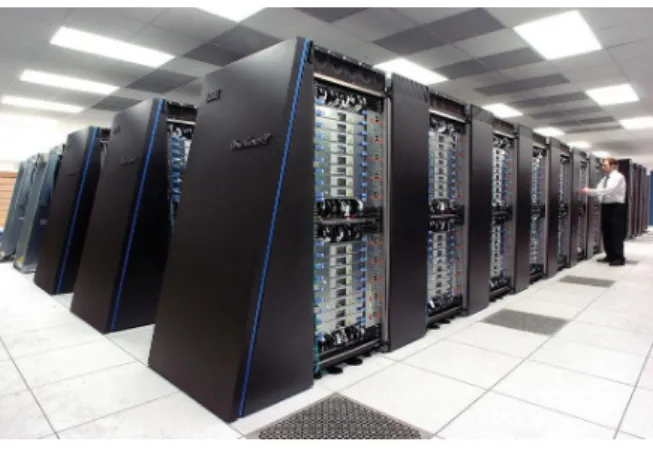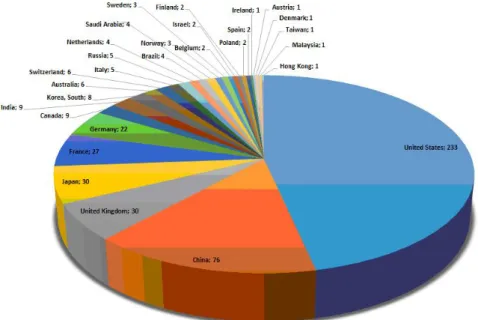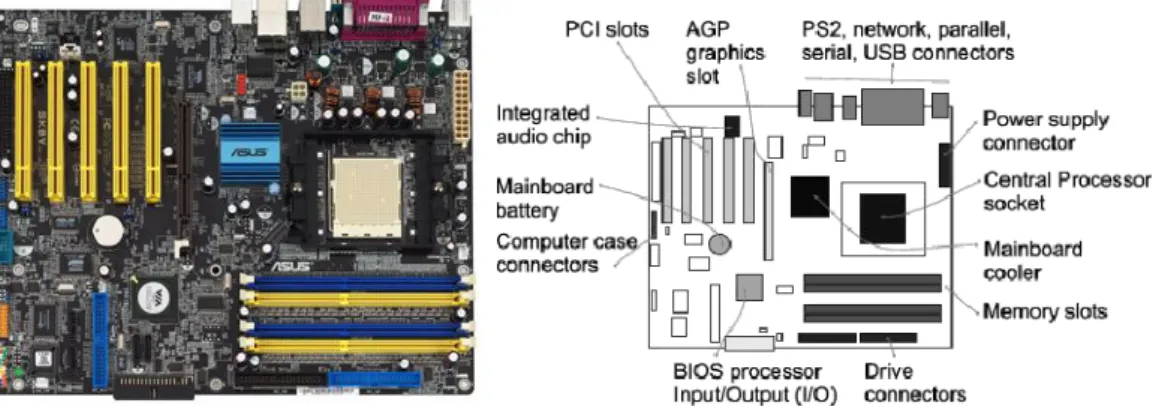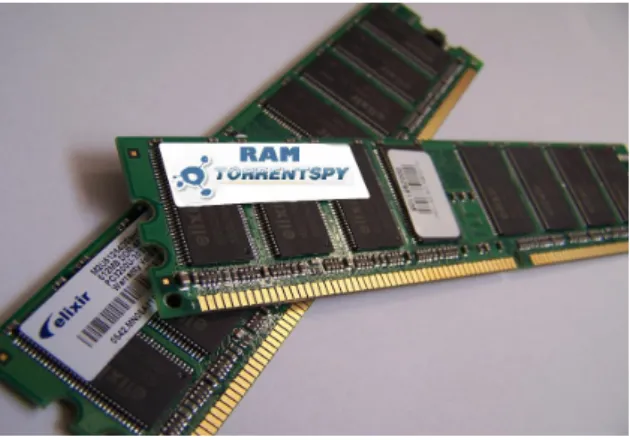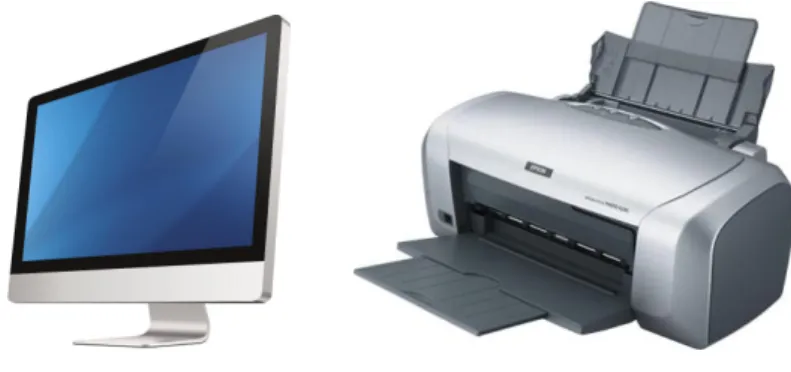Chapter 1 Fundamental of Computer
计算机历史
1.1 An Introduction of computer
A computer is a generalpurpose device that can be programmed to carry out a set of arithmetic or logical operations automatically. Since a sequence of operations can be readily changed, the computer can solve more than one kind of problem. [1]
According to modern societies’ requirements, Internet becomes one of the most important current technologies. And computers is the most important carrier. With the advent of the Internet and higher bandwidth data transmission, programs and data that are part of the same overall project can be distributed over a network and embody the Sun Microsystems slogan: "The network is the computer."
1.1.1 Computer’s History
Most histories of the modern computer begin with the Analytical Engine envisioned by Charles Babbage following the mathematical ideas of George Boole, the mathematician who first stated the principles of logic inherent in today's digital computer. Babbage's assistant and collaborator, Ada Lovelace, is said to have introduced the ideas of program loops and subroutines and is sometimes considered the first programmer. Apart from mechanical calculators, the first really usable computers began with the vacuum tube, accelerated with the invention of the transistor, which then became embedded in large numbers in integrated circuits, ultimately making possible the relatively lowcost personal computer.
Modern computers inherently follow the ideas of the stored program laid out by John von Neumann in 1945. Essentially, the program is read by the computer one instruction at a time, an operation is performed, and the computer then reads in the next instruction, and so on.
1.1.2 An Introduction of computer
The first computer in the world was born in 15 th , February, 1946. The computer was named as ENIAC, is shown in Fig 1.1 (Electronic Numerical Integrator and Computer), at the U.S. Army's Aberdeen Proving Ground in Maryland.
Whole machine was built in a metal cabinet, which weighed 30 tons and was eight feet high, three feet deep, and 100 feet long. The Computers were using vacuum tube technology, the system
contained over 18,000 vacuum tubes that were cooling by 80 air blowers, Fig 1.2.
Fig 1.1 the everfirst computer ENIAC
Fig 1.2 ENIAC’s vacuum tubes
Programs were loaded into memory manually using switches, punched cards, or paper tapes (see Fig1.3 and 1.4).
Fig 1.4 Punch card 1.1.3 Computers’ classified
After ENIAC appeared, computers were developing faster and faster. Base on the main contents and inner components, computers are classified as five generations.
l First Generation Computers
The first generation computers employed during the period 1940-1956, which used the vacuum tubes technology for calculation as well as for storage and control purpose. Using vacuum tubes brought some advantages in that period:
(1) Fastest computing devices of their time, for example, ENIAC can control addition 5,000 times/sec.
(2) These computers were able to execute complex mathematical problems in an efficient manner.
Also, the disadvantages had to be considered:
(1) The functioning of these computers depended on the machine language. (2) There were generally designed as specialpurpose computers.
(3) The use of vacuum tube technology makes these computers very large and bulky.
(4) They were not easily transferable from one place to another due to their huge size and also required to be placed in cool places.
(5) They were single tasking because they could execute only one program at a time. (6) The generated huge amount of heat and hence were prone to hardware faults.
l Second Generation Computers
The second generation computers employed during the period 1956-1963, which used transistors in place of vacuum tubes in building the basic logic circuits.
The advantages of this generation were: (1) Fastest computing devices of their time; (2) Easy to program because of the use assembly language; (3) Could be transferred from one place to other very easily because they were small and light; (4) Required very less power in carrying out their operations; (5) More reliable, did not require maintenance at regular intervals of time.
Fig 1.5 Transistors This generation had some disadvantages:
(1) The input and output media were not improved to a considerable extent (2) Required to be placed in airconditioned places
(3) The cost of these computers was very high and they were beyond the reach of home users (4) Specialpurpose computers and could execute only specific applications
l Third Generation Computers
Generally, the third generation was called Integrated Circuits era and employed during the period 1964-1975.
The advantages of 3 rd generation were: (1) Fastest computing devices;
(2) Very productive;
(3) Easily transportable from one place to another because of their small size; (4) Use highlevel languages;
(5) Could be installed very easily and required less space; (6) Can execute any type of application;
(7) More reliable and require less frequent maintenance schedules. They also provided so many disadvantages, such as :
(1) The storage capacity of these computers was still very small;
(2) The performance of these computers degraded while executing large applications, involving complex computations because of the small storage capacity;
(3) The cost of these computers was very high;
(4) They were still required to be placed in airconditioned places.
l Fourth Generation Computers
The fourth generation computers employed during 1975-1989 and people are known this generation as Large Scale Integration technology and Very Large Scale Integration technology. Meanwhile, the term Personal Computer (PC) became known to the people during this era.
Compare with other generation, this era’s advantages were:
(1) Very powerful in terms of their processing speed and access time; (2) Storage capacity was very large and faster;
(3) Highly reliable and required very less maintenance; (4) Userfriendly environment;
(5) Programs written on these computers were highly portable; (6) Versatile and suitable for every type of applications; (7) Require very less power to operate.
And the disadvantages were:
(1) The soldering of LSI and VLSI chips on the wiring board was not an easy task and required complicated technologies to bind these chips on the wiring board;
(2) The working of these computers is still dependent on the instructions given by the programmer.
l Fifth Generation Computers
The different types of modern digital computers come under this category.
Use Ultra Large Scale Integration technology that allows almost ten million electronic components to be fabricated on one small chip. Therefore, this category brings so many benefits rather than disadvantages, such as:
(1) Fastest and powerful computers till date;
(2) Being able to execute a large number of applications at the same time and that too at a very high speed;
(3) Decreasing the size of these computers to a large extent;
(4) The users of these computers find it very comfortable to use them because of the several additional multimedia features;
(5) They are versatile for communications and resource sharing.
Sometimes, people define computers’ category according to the following three criteria: operating principles, applications, or size and capability.
If people only consider on operating principles, all computers can separate as 3 different types.
l Analog computers, which represent data in the form of continuous electrical signals
having a specific magnitude.
l Digital computers, which generally store and process data with the digital format.
l Hybrid computers, which are a combination between analog computer and digital
computer for presenting the best features of those 2 types of computer.
If based on applications, there are General purpose computers (work in all environments) and
Special purpose computers (perform only a specified task).
Base on their abilities, they classified computers into supercomputer, mainframe computer, server, and personal computer (well known as PC, which includes handheld computer, desktop computer, notebook computer and tablet computer).
For general usage, a personal computer (PC) is a microcomputer designed for use by one person at a time. Prior to the PC, computers were designed for (and only affordable by) companies who attached terminals for multiple users to a single large computer whose resources were shared among all users. The term "PC" has been traditionally used to describe an "IBMcompatible"
personal computer in contradistinction to an Apple Macintosh computer. Although the distinctions have become less clearcut in recent years, people often still categorize a personal computer as either a PC or a Mac.
A handheld computer is shown in Fig 1.6. Usually the computer contains small keyboard or touchsensitive screen and is designed small enough to fix into a pocket. Also, it is wireless and easy to hold when users are using. People can use handheld computer with some basic functions: appointment book, address book, calculator, and notepad.
Fig 1.6 Image for handheld computer
A desktop computer(see Fig 1.7) is commonly used in the public, which contains monitor, keyboards, mouse, and a main cabinet. This type of computer is popular for offices, schools, and homes.
Fig 1.7 Image for desktop computer
A notebook computer (or called laptop) (see Fig 1.8) is a small lightweight personal computer that incorporates a screen, a keyboard, storage devices, and processing components into a single portable unit. Notebook computer can run on power supplied by an electrical outlet or a battery.
A tablet computer(see Fig 1.9) is a recently popular portable computing device featuring a touchsensitive screen. A tablet configuration lacks of a keyboard and resembles a hightech clipboard. When tablet computers were firstly come to the public in 2002, they were significantly
more popular than every other type of computers for normal user.
Fig 1.8 Image for notebook computer Fig 1.9 Image for tablet computer
A supercomputer(see Fig 1.10) is a computer with a highlevel computational capacity compared to a generalpurpose computer. Performance of a supercomputer is measured in Floatingpoint Operations Per Second (FLOPS) instead of Million Instructions Per Second (MIPS). As of 2015, there are supercomputers which can perform up to quadrillions of FLOPS. [2]
Supercomputers play an important role in the field of computational science, and are used for a wide range of computationally intensive tasks in various fields, including quantum mechanics, weather forecasting, climate research, oil and gas exploration, molecular modeling (computing the structures and properties of chemical compounds, biological macromolecules, polymers, and crystals), and physical simulations (such as simulations of the early moments of the universe, airplane and spacecraft aerodynamics, the detonation of nuclear weapons, and nuclear fusion). Throughout their history, they have been essential in the field of cryptanalysis. [3]
Fig 1.10 IBM’s Blue Gene Supercomputer
In current situation, super computers’ quantity can be considered as the modern technology measurements. Until 2014, the super computers’ numbers of each country are shown below:
A mainframe (also known as "big iron") is a highperformance computer used for largescale computing purposes that require greater availability and security than a smallerscale machine can
offer. Historically, mainframes have been associated with centralized rather than distributed computing, although that distinction is blurring as smaller computers become more powerful and mainframes become more multipurpose (see Fig 1.1 and 1.12).
Fig 1.11 Supercomputer in different countries June, 2014
Fig 1.12 IBM Z9 Mainframe
In information technology, a server is a computer program that provides services to other computer programs (and their users) in the same or other computers. The purpose of a server is to “serve” data to computers connected to a network. Despite impressive performance a server can offer, these servers usually cannot use for entertainments such as sound or DVD players, and other fun accessories, so they are not suitable for a personal computers.
1.2 Numbering System
Numbering system is used by people every day. The most common one is the decimal system, which also has been known as Arabic number system.
1.2.1 An overview of the Numbering System
At present, there are so many different numbering systems have been used in several of fields. The Binary Code, Octal Decimal Number and Hexadecimal Number are offering in computer world.
Since we were little kids, we started the decimal numeral system and which is a based on the Arabic numeral system.
In the decimal numbers, it contains 10 basic numbers:0、1、2、3、4、5、6、7、8、9. It uses positional notation and uses same symbols for different orders of magnitude, but in different places. For example, ones place, tens place, hundreds place. All numbers can be presented as 10 0 ,10 1 ,10 2 ,10 3 , etc. Also, the decimals can be shown as 10 1 , 10 2 . For example: In decimal, (2317.87)10 means: (2317.87)10=2*10 3 +3*10 2 +1*10 1 +7*10 0 +8*10 1 +7*10 2
Therefore, as a decimal number (present as D) we can follow the rule. (D) 10= (Dn1Dn2……D1D0.D1D2……Dm) 10 = Dn1*10 n1 +Dn2*10 n2 +……+D1*10 1 +D0*10 0 +D1*10 1 +D2*10 2 +……+Dm*10 m 1.2.2 Binary Code
Since computer’s born, they only know two numbers 0 and 1. People bring the binary numbering system to communicate with them. So in the binary system, it is a based on the binary representation (0, 1). Similar with decimal numbering system, it also uses positional notation and uses the same symbols for different orders of magnitude, but in different places, e.g., ones place, twos place, fours place.
All numbers can present as 2 0 ,2 1 ,2 2 ,2 3 , etc. For example: (10010.11)2 means
(10010.11)2=1*2 4
+0*2 3 +0*2 2 +1*2 1 +0*2 0 +1*2 1 +1*2 2 =16+0+0+2+0+0.5+0.25
=(18.75)10
So, for any binary code B, we can present as: (B) 2= (Bn1Bn2……B1B0.B1B2……Bm) 10 = Bn1*10 n1 +Bn2*10 n2 +……+B1*10 1 +B0*10 0 +B1*10 1 +B2*10 2 +……+Bm*10 m 1.2.3 Other Numbering System
Normally, any numbering system N can be presented as: (N)m= (Nn1Nn2……N1N0.N1N2……Nm) m = Nn1*m n1 +Nn2*m n2 +……+N1*m 1 +N0*m 0 +N1*m 1 +N2*m 2 +……+Nm*m m
In this system, Ni can be present as any numbers, such as 0.1.2……m; N and m are integer.
When m=2, 8, 16, or 10, the numbering systems are Binary code, Octal numbers, Hexadecimal numbers and Decimal numbers.
1.2.4 Conversion between Different Numbering Systems (1) Converting from other numbering systems to Decimal.
Any numbering systems are easy to convert to decimal numbers by multiply power series, for example: (1001.101)2=1*2 3 +0*2 2 +0*2 1 +1*2 0 +1*2 1 +0*2 2 +1*2 3 =8+0+1+0.5+0+0.125 =9.625 (56)8=5*8 1 +6*8 0 =40+6 =46 (3CF.BA)16=3*16 2 +C*16 1 +F*16 0 +B*16 1 +A*16 2 =768+12*16+15*1+11*0.0625+10*0.00390625 =975+0.06640625 = (975.06640625)10
(2) Converting from Decimal numbering system to other numbering system.
l Decimal transfer to Binary code
Decimal number transfer to Binary code should follow these rules: calculate into integer part and decimal part. Integer part should be divided by 2 and keep reminders, and decimal parts should be multiplied by 2 and keep integers. For example:
We convert (85.35)10 to Binary code.
First of all, we calculate the integer part (85)10=(an1 an2... a1 a0 )2
Division Quotient Remainder
85/2 42 1 a0 42/2 21 0 a1 21/2 10 1 a2 10/2 5 0 a3 5/2 2 1 a4 2/1 0 1 a5
Secondly, we calculate the decimal part (0.135)10=(a1 a2... am )2
Multiplication Fraction Integer
0.35*2 0.7 0 a1
0.7*2 0.4 1 a2
0.4*2 0.8 0 a3
And then, we add those two results (85.35)10= (110101.0101)2
l Decimal convert to Octal and Hexadecimal number
Similar with conversion between decimal and binary code, decimal convert to octal number should be divided by 8 and keep the reminders and decimal parts also should be multiplied by 8 and keep integers. For hexadecimal numbers, we use 16 for division and multiplication.
(3) Conversion between Binary to octal numbers
l Conversion between Binary to octal numbers
The converting rule is separating in two parts base on the decimal point. Before the decimal point, the integer part should count 3 digits as a group from right to left. If the left digits cannot have 3 digits, we use 0 to fit in. The decimal part also counts 3 digits as a group from left to right. If the left digits cannot have 3 digits, we use 0 to fit in. For example, we convert (110000110101.0010001011)2 to an octal number. The integer part is (1110000110101)2. 001 110 000 110 101 1 6 0 6 5 The decimal part is (.0010001011)2 001 000 101 100 1 0 5 4
So, we have the result (16065.1054)8
l Conversion between octal to Binary numbers
We can transfer each octal digit to 3 binary digits, for example: (1765.03)8.
1 7 6 5 . 0 3
001 111 110 101. 000 011 (4) Conversion between Binary to Hexadecimal numbers
l Conversion between Binary to Hexadecimal numbers
The converting rule is similar with octal number and separating in two parts base on the decimal point. Before the decimal point, the integer part should count 4 digits as a group from right to left. If the left digits cannot have 4 digits, we use 0 to fit in. The decimal part also counts 4 digits as a group from left to right. If the left digits cannot have 4 digits, we use 0 to fit in. For example, we use same number (110000110101.0010001011)2 to transfer a hexadecimal number.
The integer part is (1110000110101)2.
0001 1100 0011 0101
The decimal part is (.0010001011)2
0010 0010 1100
2 2 C
Even though we use same binary code, we receive different result (1C35.22C)8
l Conversion between Hexadecimal to Binary numbers
We can transfer each hexadecimal digit to 4 binary digits, for example :(1AE5.03)16.
1 A E 5. 0 3
0001 1010 1110 0101. 0000 0011 For better calculation, we provide a table (Table 1.1).
Table 1.1
Decimal 0 1 2 3 4 5 6 7 8 9 10 11 12 13 14 15 16
Binary 0 1 10 11 100 101 110 111 1000 1001 1010 1011 1100 1101 1110 1111 10000
Octal 0 1 2 3 4 5 6 7 10 11 12 13 14 15 16 17 20
Hexadecimal 0 1 2 3 4 5 6 7 8 9 A B C D E F 10
1.3 Computer System
A computer system is consisting of hardware and software. Also, data and human beings are indispensable parts of computer system.
1.3.1 Hardware
Computer hardware (usually simply called hardware when a computing context is concerned)
is the collection of physical elements that constitutes a computer system. Computer hardware is the physical parts or components of a computer, such as the monitor, mouse, keyboard, computer data storage, hard disk drive (HDD), graphic cards, sound cards, memory, motherboard, and so on, all of which are physical objects that are tangible.
Hardware consists of different parts, which can be shown as below:
Computer Inner Devices Outer Devices CPU ALU (Algorithm and Logic Unit) CU (Control Unit) Mainboard Other Cards (Display Card, Voice Card, Modern Card, and etc.) Memory ROM (Read Only Memory) RAM (Random Access Memory) Storage Input and Output Devices Keyboard and Mouse Monitor, Printer, and Projector
1. Processor
The processor is the brain of a computer, which is the logic circuitry that responds to and processes the Basic instructions that drives a computer. The term processor has generally replaced the term Central Processing Unit (CPU). The processor in a personal computer or embedded in small devices is often called a microprocessor (see Fig 1.13).
A processor combines 2 units, one is ALU, and the other is CU. The ALU controls all the logical process, for example AND, OR, XOR. The CU mainly charges with execution of the instructions, and controls the data sequence of in and out. The result of these routed data movements through various digital circuits (subunits) within the processor produces the manipulated data expected by a software instruction (loaded earlier, likely from memory).
When data and instruction are waiting for ALU and CU to process, there are some small units can store them temporarily. Those small units also called as register. Depending on the processors, the registers may store 8, 16, 32, or 64 bits. Those storage sizes control processors’ performance, which also call words. Therefore, we have nbits processors, such as 32bits processor or 64bits processor.
Fig 1.13 a CPU processor
2. Mainboard
Mainboard (Motherboard) is shown below. Since Personal Computer (PC) has invented, mainboard is the most important part to connect each computer parts (see Fig 1.14).
The mainboard consists of:
l Central Processor Sockets (or slots) in which one or more microprocessors may be installed. In the case of CPU's in ball grid array packages, such as the VIA C3, the CPU is directly solidified to the motherboard. .[4]
l Memory slots into which the system's man memory is to be installed (typically in the form
of DIMM modules containing DRAM chips).
l A clock generator which produces the system clock signal to synchronize the various components,which connect with mainboard battery and charge with system timing.
l Slots of expansion cards (for example the interface to the system via the buses supported by the chipset).
l Power connectors, which receive electrical power from the computer power supply and distribute it to the CPU, chipset, main memory, and expansion cards. As of 2007, some graphics cards (e.g. GeForce 8 and Radeon R600) require more power than the motherboard can provide, and thus dedicated connectors have been introduced to attach them directly to the power supply. [5]
l Connectors for hard drives, typically SATA only. Disk drives also connect to the power supply.
3. Other Cards
When computers communicate with people or real world, these need some devices to connect each other. Some cards are necessarily responsible for this, such as Display Card, Voice Card, Modem Card, etc.
A Video Card is a discrete dedicated circuit board, silicon chip and necessary cooling that provides 2D, 3D and sometimes even general purpose graphics processing calculations for a computer. Alternate terms include graphics card, display adapter, video adapter, video board and almost any combination of the words in these terms.
Voice card is responsible for transform digital signal to analog signal, in order to play voice through speakers or headphones.
A modem (the term is concatenated by Modulator and Demodulator) modulates outgoing digital signals from a computer or other digital device to analog signals for a conventional copper twisted pair telephone line and demodulates the incoming analog signal and converts it to a digital signal for the digital device. Currently, there are so many different modem card, such as 3G card and cable card.
4. Memory
Computer memory store massive 2 state data, 0 and 1. To choose 0 and 1 as computer’s status is most electrical devices have 2 different situations, “on” and “off”. If the status is “On”, 1 can be stored. If the status is “Off”, 0 can be stored.
All data or information (text, video, sound, and pictures), which is stored into a computer, are all presented as many 1s and 0s. So when people consider storage capacity, those following units are commonly used:
8 bits(b)=1 byte(B) 1024 bytes= 1 Kilobyte(KB) 1024 KB= 1 Megabyte(MB) 1024 MB= 1 Gigabyte(GB) 1024 GB= 1 Terabyte(TB) 1024 TB= 1 Petabyte(PB)
In computing, memory refers to the computer hardware devices used to store information for immediate use and wait for CPU to process and sometimes it is synonymous with the term "primary storage". Computer memory operates at a high speed, for example, randomaccess memory (RAM), as a distinction from storage that provides slowtoaccess program and data storage but offers higher capacities. If needed, contents of the computer memory can be transferred to secondary storage, through a memory management technique called "virtual memory".
For computer memory, there are 2 parts. One is RAM(random access memory), the other one is ROM(read only memory). ROM is "builtin" computer memory containing data that normally can only be read, not written to. ROM contains the programming that allows users’ computer to be "booted up" or regenerated each time they turn it on. Unlike a computer's random access memory (RAM), the data in ROM cannot be lost when the computer power is reboot. The ROM is sustained by a small longlife battery in computer. Therefore, if users ever do the hardware setup procedure with their computers, they effectively will be writing to ROM. Also, ROM should be seen as inner devices.
RAM (random access memory) is the place in a computer where the operating system (see Fig 1.15), application programs, and data in current use are kept so that they can be quickly reached by the computer's processor. RAM is much faster to read from and write to than the other kinds of storage in a computer, the hard disk, floppy disk, and CDROM. However, the data in RAM stays there only as long as people’s computer is running. When users turn the computer off, RAM loses its data. When they turn computer on again, their operating system and other files are once again loaded into RAM, usually from user’s hard disk. And RAM is considered as outer devices.
5. I/O devices
(1) Input Devices
An input device is a peripheral (piece of computer hardware equipment), which used to transfer data and control signals to an information processing system such as a computer or information appliance. Examples of input devices include keyboards, mouse, scanners, digital cameras and joysticks.
A keyboard like Fig 1.16 is a human interface device which is represented as a layout of buttons. Each button, or key, can be used to either input a linguistic character to a computer, or to invoke a particular function of the computer(for example F1 to F12, Wake up, PrintScreen or etc.). They act as the main text entry interface for most users. It is typewriter like device composed of a matrix of switches.
Fig 1.16 The image of standard keyboard
A computer mouse is a pointing device that detects twodimensional motion relative to a surface. This motion is typically translated into the motion of a pointer on a display, which allows a smooth control of the graphical user interface. Physically, a mouse consists of an object held in one's hand, with one or more buttons.
Fig 1.17 The image of mouse
Pointing devices are the most commonly used input devices today. A pointing device is any
human interface device that allows a user to input spatial data into a computer. In the case of mouse and touchpads, this is usually achieved by detecting movement across a physical surface. Analog devices, such as 3D mice, joysticks, or pointing sticks, function by reporting their angle of deflection. Movements of the pointing device are echoed on the screen by movements of the pointer, creating a simple, intuitive way to navigate a computer's graphical user interface (GUI).
(2) Output Devices
data processing carried out by an information processing system (such as a computer) which converts the electronically generated information into humanreadable form (see Fig 1.18).
A display device is an output device that visually conveys text, graphics, and video information. Information shown on a display device is called soft copy because the information exists electronically and is displayed for a temporary period of time. Display devices include CRT monitors, LCD monitors and displays, gas plasma monitors, and televisions.
Fig 1.18 Output Devices Monitor and Printer
In computers, a printer is a device that accepts text and graphic output in a digital signal from a computer and transfers to the real text or picture to paper, usually to some standard size sheets of paper. Printers are sometimes chosen by customers with their requirements and are purchased separately. Printers vary in size, speed, sophistication, and cost. In general, more expensive printers are used for higherresolution color printing. By their performance, printers can be classified as stylus printer, ink printer, and laser printer.
A digital projector(see Fig 1.19), also called a digital projection display system, is a specialized computer display that projects an enlarged image on a movie screen. Such devices are commonly used in presentations or home theater.
There are two main types of digital projection display systems. The older, less expensive type employs three transparent liquidcrystaldisplay (LCD) panels, one for each of the primary colors (red, green, and blue). A newer, more expensive scheme is known as Digital Light Processing (DLP), a proprietary technology developed by Texas Instruments.
6. Storage
Except memory, in a computer system, there are so many different types of storage devices. Flash disk (USB disk), CD, and portable disks are all commonly used in computer fields (see Fig 1.20 & 1.21).
Nowadays, Flash disk is the most commonly used portable storage. The storage capacity of flash disk is 64KB, 128KB, or even more. People carry them very easily and also have enough storage for normal files transfer from one computer to another.
Fig 1.20 Normal storage (Flash disk and Portable disk)
Portable disk normally use for store software and documents. Users can input largescale
documents into these storage devices. Compare with USBdisk, the portable disk has bigger capacity and better performance. Using portable disk, users can move files with higher speed than the flash disk. Data in the portable disk can be transferring to a computer for any time users’ want.
CD (Compact Disc) is a data storage format in the digital optical disc. This format was
originally developed to store and play only sound recordings, but was later adapted for storage of data (CDROM). Standard CDs have a diameter of 120 millimeters (4.7 in) and can hold up to about 80 minutes of uncompressed audio or about 700 MiB of data.
Fig 1.21 The Image of Compact Disc 1.3.2 Software
encoded information or computer instructions, in contrast to the physical hardware from which the system is built. The term is roughly synonymous with computer program, but is more generic in scope.
Base on the usage of computer system, software are divided into 3 catalogues: system software, programming software and application software.
1. System software
System software is computer software designed to provide services to other software or set the communication between human and computers. Examples of system software include operating systems, computational science software, game engines, industrial automation, and software as a service application.
The operating system (common examples are Microsoft Windows series, Mac OS X, Linux, and Unix), allows the parts of a computer to work together by performing tasks like transferring data between memory and disks or rendering output onto a display device in an understandable stylegraphic. It provides a platform (hardware abstraction layer) to run highlevel system software and application software.
2. Programming Software
A programming tool (or software development tool) is a type of computer program that software developers use to create, debug, maintain, or otherwise support other programs and applications. Programming Software usually refers to relatively simple programs, that can be combined together to accomplish a task. The ability to use a variety of tools productively is one distinctive characteristic of a skilled software engineer.
The most basic tools are an Integrated Development Environment (IDE) and a compiler or interpreter, which are used ubiquitously and continuously. Other tools are used more or less depending on the language, development methodology, and individual engineer, and are often used for a discrete task, like a debugger or profiler. IDE also may be discrete programs, executed separately – often from the command line – or may be parts of a single large program. In many cases, particularly for simpler use, simple and special techniques are used instead of a tool, such as print debugging instead of using a debugger, manual timing (of overall program or section of code) instead of a profiler, or tracking bugs in a text file or spreadsheet instead of a bug tracking system.
The distinction between tools and applications usually is not very clear. For example, developers use simple databases (such as a file containing a list of important values) all the time as tools. However a fullfunction database is usually thought of as an application or software in its own right.
3. Application Software
An application program (app or application for short) is a computer program designed to perform a group of coordinated functions, tasks, or activities for the benefit of the user. Mostly common used software are all application software, such as word processor (Microsoft Word or WPS), a spreadsheet (Excel), an accounting application (wellknown as Enterprise Resources Planning or called ERP), a web browser (Internet Explorer or called as IE), a media player
(Windows Media Player), an aeronautical flight simulator, a console game or a photo editor (Photoshop). The collective name of application software refers to all applications collectively. This contrasts with system software, which is mainly involved with running the computer.
Applications may be packed with the computer and its system software or published separately, and may be coded as proprietary, opensource or university projects.
1.4 Reference
[1] “November 2014”, Top 500, Retrieved 17 January 2015.[2] “The List: November 2015”, Top 500, Retrieved 24 January 2016.
[3] Lemke, Tim, “NSA Breaks Ground on Massive Computing Center”, Retrieved 11 December 2013.
[4] “CPU Socket Types Explained: From Socket 5 To BGA [MakeUseOf Explains]”, Retrieved 12 April 2015. [5] “Pinout of the PCIExpress Power Connector”,techPowerUp, Retrieved 2 October 2013.
1.5 EnglishChinese Key Terms
Analog device 模拟设备 Bit 位 Byte 字节 Binary 二进制 BIOS 基本输入输出系统 Octal 八进制 Hexadecimal 十六进制 Computer 计算机 Input 输入 Output 输出 Desktop 台式机 Display device 显示器Handheld computer 掌上电脑 Server 服务器
Tablet computer 平板电脑 Keyboard 键盘
Key 按键 Mainframe computer 大型机
Memory 内存 Slots 插槽
Personal computer 个人电脑 Motherboard (mainboard) 主板
Modem 调制解调器 Notebook 笔记本电脑
ALU (arithmetic logic unit) 算术逻辑单元 ASCII 美国信息交换标准代码
IDE (Integrated Development Environment) 集成开发环境 CPU (Central Processing Unit) 中央处理单元
